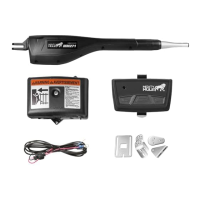11
E
A
B
C
DD
F
A –Level D – Posts Secured in Concrete
B – Plumb E – Centerline Mounting
C – Free Swinging F – Good Working Hinges
Gate Grounding
¾ For reference only.
Cooper Clad Ground Rod (not included)
Use an 8 foot, 5/8 inch ground rod, positioned two
feet or less from the post and 2 inches or less
above the ground. Available at local home center or
hardware stores.
NOTE: No grounding system absolutely protects
against lightning strikes. If installed correctly, a
grounding system will help minimize damage to your
gate operator.
¾ The gate must be plumb, level, and swing freely on its hinges.
¾ The gate must move throughout its arc without binding or dragging on the ground.
¾ Wheels must NOT be attached to the gate.
¾ Gates over 250 lb. should have ball bearing hinges with grease ttings.
¾ Post must be secured in the ground with concrete (minimizes twist/ex when the operator is activated).
¾ Make sure there is a stable area for mounting the gate bracket (this may require the addition of a horizontal or vertical
cross member).
¾ We recommend you position the operator near the center-line of the gate to keep the gate from twisting and exing, and
to avoid back-splash from rain.
Copper clad ground rod
(not included)
Ground
Ground
2 Inches or
Less above
ground
Copper ground
rod clamp
Copper Single
Conductor Lug
3/16” Drilled
Pilot Hole
6 ft. deep
or more
Metal Gate Post
2 ft. or Less
from post
IMPORTANT: Check for Proper Gate Installation
Check Existing Gate Size and Material
• Gate size: Up to 12 feet and up to 300 lbs • Type of gate material: Vinyl, aluminum, chain link, farm
tube, wrought iron, wood.
Not rated for use on solid surface gates.
- Plumb
- Free Swinging
D - Secured Posts Concrete
E - Center line Mounting
F - Good Working Hinges (ball bearing hinges are recommended on gates over 250 pounds)

